![]()
![]()
![]()
Use LEFT and RIGHT arrow keys to navigate between flashcards;
Use UP and DOWN arrow keys to flip the card;
H to show hint;
A reads text to speech;
40 Cards in this Set
- Front
- Back
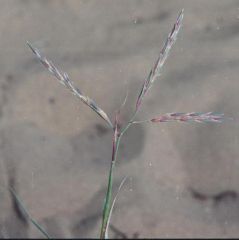
|
Big Bluestem/ P/N
Andropogoneae/ andropogon gerardii < large bunchgrass with thick base < seedhead is a panicle with 2-6 digitate (finger-like) branches < 2 florets per spikelet; one floret with awn, one infertile and awnless < can have extensive scaly rhizomes < Andropogon translates to andro=“man’s” + pogon=“beard”; gerardii = for Gerard |
|
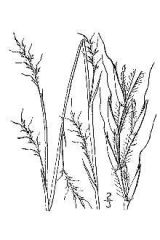
|
Little Bluestem P/ N
Andropogoneae/ schizachyrium scoparium < mid-sized bunchgrass; tufted plant with short rhizomes < plant about half the size of Andropogon gerardii < sheaths and culms flat at base < seedhead has several small recemes in a panicle-type arrangement < each seed has a small “kinky” awn < Schizachyrium translates to schiz=“split” + achyr=“chaff” + ium=“small”; scoparium = broom-like |
|
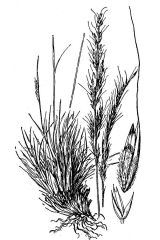
|
Montana muhly P/ N
Eragrosteae/ Muhlenbergia Montana < densely tufted bunchgrass < leaves more basal and pointed < seedhead is a narrow panicle Narrow Contracted < spikelets 1-flowered, Long single awn up to 1 " < glumes with purplish or dark green bands, first glume ends in 3 teeth (like a mountain) Short Awns. < Muhlenbergia = after Gotthilf Heinrich E. Muhlenberg, an American Botanist and Lutherin Minister (1753-1815); montanta = “of the mountains” |
|
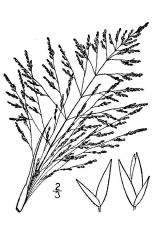
|
Alkali Sacaton P/N
Eragrosteae/ Sporobolus airoides < large tufted plant with white woody base < seedhead is an open panicle; wide & pyramidal, Often Purple < florets 1-flowered, florets are round (like a spore)NO AWNS < lower portion of panicle usually not enclosed in sheath as in the other Sporoboluses < Sporobolus translates to sporo=”casting or throwing” + bolus=”seed”; airoides translates to oides=”like” + aira=”darnel grass |
|
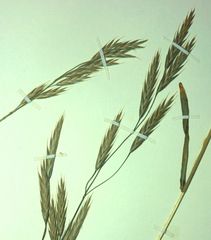
|
Mountain Brome P/N
Bromeae/ Bromus Carinatus < large bunchgrass with long flat blades < seedhead is a panicle with spreading or drooping branches < spikelets with 6-10 florets < glumes are small and without awns; florets have short stiff awns < Bromus means “food”; carinatus = “keeled or with keel-like ridge” |
|
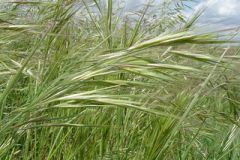
|
Ripgut Brome P/I
Bromeae/ Bromus Diandrus < mid-sized bunchgrass with weak annual roots < seedhead is a panicle with stout, erect, and scabrous branches < 4-8 florets per spikelet with a long, stout, scabrous awns < glumes unequal with barbs on back, but no awns < Bromus means “food”; diandrus = “two” (di) “stamens” (andrus) |
|
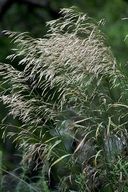
|
Smooth brome/ P/I
Bromeae/ Bromus Inermis < sodgrass with creeping rhizomes (rhizomatous) < wide flat leaves with a conspicuous "M" or “W” constriction on blade < seedhead is an erect panicle with smooth whorled branches < spikelets 5-13 flowered and round in cross-section < spikelets awnless (rarely with short awns); glumes awnless < Bromus means “food”; inermis = “without spines”; in this case, without awns |
|

|
Cheat grass, Downy brome/ A/I
Bromeae/ Bromus Tectorum < small bunchgrass with weak annual roots < leaf blades, sheaths, and glumes are hairy (pubescent) < seedhead is a panicle with slender, weak branches so that spikelets hang in disarray < spikelets have 2-8 florets that often turn purple at maturity < florets have stiff, scabrous awns; glumes are awnless < Bromus = “food”; tectorum = “growing on roof tops”; it often grew on sod roofs in Europe |
|

|
Wild white/ P/N
Geraniaceae/ Geranium richardsonii < a relatively large, erect forb with pubescent stems rising from a thick rootstock < leaves palmately 3-7 lobed, basal leaves on long petioles < leaves arise from whorls at base and at few places on stem < flowers are white to pink flowers with 5 sepals and 5 petals < seeds have a long beak (typical geranium fruit) < Geranium = “crane” referring to fruit which resembles a stork head; richardsonii = probably named for Sir John Richardson, a Scottish naturalist. |
|
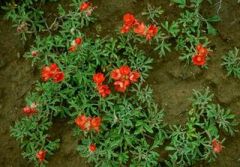
|
Scarlet Globe mallow P/N
Malvaceae/ Sphaeralcea Coccinea < a small forb (erect or decumbent) with leafy stems < leaves deeply and palmately lobed (3-5 lobes) with petioles < leaves covered with stellate pubescence (hairs in star-shaped groups of 5) < flower are melon colored with 5 petals (regular) < Spaeralcea = globular (sphaer) + mallow-like (alcea); coccinea = scarlet |
|
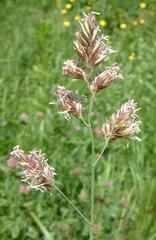
|
Orchardgrass P/I
Poeae/ Dactylis glomerata < usually a tufted plant with stems flat at base; introduced forage grass < seedhead is a panicle with spikelets in dense clusters at the end of the branches < spikelets are 2-5 flowered, nearly sessile < glumes and lemmas have distinct hairs on keel in a comb-like arrangement < Dactylis means “bunched”; glomerata=”collected into heads” both terms refer to inflorescence |
|
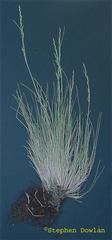
|
Idaho fescue P/N
Poeae/ Festuca Idahoensis < mid-sized bunchgrass (tufted) with fibrous black roots < leaves thin, rolled, filiform and usually scabrous; cast a blue or purplish tint < seedhead is a panicle that is narrow but loose < spikelets 5-7 flowered < lemmas have awns (2-4mm), glumes awnless < Festuca means “straw”; idahoensis, of course, means “from Idaho” |
|

|
Kentucky Bluegrass P/I
Poeae/ Poa Pratensis < rhizomatous grass that can be a strong sodgrass or slightly tufted depending on soil < introduced turf and forage grass < leaves are thin, leaf tips are boat-shaped (keeled) < seedhead is a typical panicle (spreading; pyramidal; lower branches whorled) < spikelets 3-6 flowered as wide as long; glumes and lemmas are awnless < Poa pratensis can be extremely variable in size & appearance < Poa means “pasturage” and is the Greek word for “grass”; pratensis = “of meadows” |
|
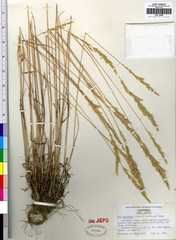
|
Sandberg Bluegrass P/N
Poeae/ Poa Secunda < densely tufted grass with a few erect culms rising above a tuft of basal leaves (<30cm) < fibrous roots < seedhead is a narrow panicle < spikelets 2-4 flowered, appearing very narrow < Poa means “pasturage”; secunda = “turned or on the side” (not sure what it refers to) |
|
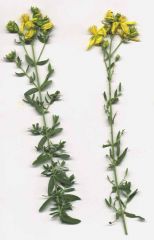
|
St. Johnswort P/I
Clusiaceae/ Hypericum perforatum < forb with single leafy stems (few basal leaves) that arise from rhizomes < stems are stiff, woody at base, often red and appear jointed due to opposite leaf scars < leaves are elliptic, sessile, and opposite < leaves have rolled margins and surfaces are covered with punctate dots < flowers red and yellow with 5 separate petals < Hypericum translates to hyper= “above” + icum = “pictures” because this genus was historically placed above pictures of people to ward off evil spirits; perforatum = “pierced with holes” referring to leaves |
|
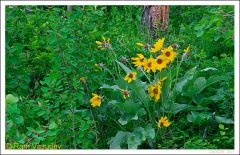
|
Arrowleaf Balsamroot P/N
Heliantheae/ Balsamorhiza sagittata < beautiful wildflower with big yellow flowers < basal leaves with long petioles; arrow-shaped (sagittate), tomentose, margins entire < few or no leaves on stem < large flowers with yellow rays and disks, usually solitary < plants have thick woody rootstocks < Balsamorhiza translates to Balsamo =“balsam” + rhiza=”root”; sagittata = “arrow shaped” |
|
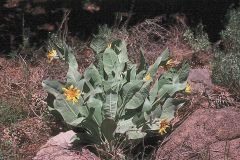
|
Mulesears P/N
Heliantheae/ Wyethia Amplexicaulis < plants have large leaves that are both basal and on the stems, a few stems per plant < large leaves taper at both ends, mostly basal, petioled, and not hairy < leaves appear waxy on surface and turn black with age because they contain tannins < veins converge at leaf margin < large yellow flower heads (ray flowers and disk flowers are yellow) < thick woody taproot with old leafstalks attached < Wyethia = Named for Nathaniel Jarvis Wyeth, an Oregon Pioneer and botanist; amplexicaulis translates to amplexi=”embracing” + caulis=”stem” referring to the clasping leaves |
|
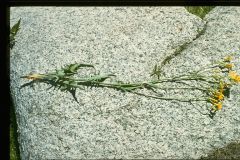
|
Tapertip Hawksbeard P/N
Cichorieae/ Crepis acuminata < forb with mostly basal leaves < resemble dandelion leaves except these have acuminate (narrow-pointed) tips < inflorescence a multi-flowered cyme (not like Aqoseris and Taraxacum) < Crepis is a term used for Theophrastis meaning “unclear”; acuminata = “narrow and pointed tip” referring to the leaf. |
|
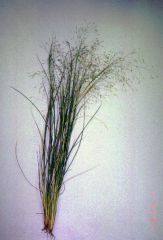
|
Indian ricegrass P/N
Stipea/ Stipa Hymenoides < a mid-sized bunchgrass with stiffly erect stems < leaves involute, filiform < seedhead is a diffuse panicle, branched many times, dichotomously < branches of panicle thin, wavy, curved < spikelets have just 1 floret, the seed is hairy and has a very small “wimpy” awn < glumes sharply pointed and longer than the spikelet < Stipa refers to a “stalk or stem” in this case the awn; hymenoides = oides=”like” + hymen=”skin or membrane, referring to thin glume |
|
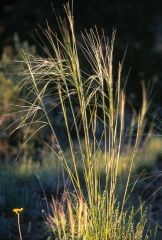
|
Needle and thread grass P/N
Stipeae/ Hesperostipa comata < a mid-sized bunchgrass, densely cespitose, but usually just a few stems per bunch < panicle narrow and sparse (compared to S. columbiana) < large spikelets with membranous glumes, one-flowered < each seed has a long awn, 10-20 cm, twisted, but not distinctly bent (sort of curly) < can be distinguished vegetatively by a long ligule < Hespero = “West” + stipa refering to a “stalk or stem” in this case the awn; comata = “like a hair” |
|
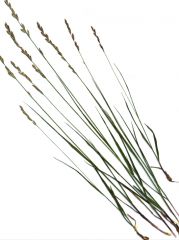
|
Oniongrass P/N
Meliceae/ Melica Bulbosa < a tufted grass; culms have bulbous bases (hence the name “onion” grass) < seed head is panicle narrow with short, stiff branches < spikelets 2-9 flowered, fairly large and oval in outline < glumes and florets are usually purple with a band of white at the tips < leaves flat to involute, pointed; scabrous or pubescent < Melica means “honey grass”; bulbosa = “swollen or bulbuous” |
|
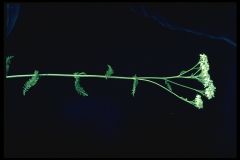
|
western yarrow P/N
Anthemideae/ achillea millefolium < a forb that is seldom tufted but occurs in patches because it is rhizomatous < flowers white in a dense flat-topped inflorescence (corymb) < leaves alternate, are finely divided (dissected), ferm-like and usually deeply green < stems have silky hairs < strong odor when leaves are crushed < Achillea is named after the Greek worrier Achilles; millefolium = “thousand-leaved” |
|
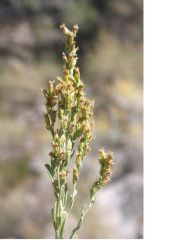
|
Black sagebrush P/N
Anthemideae/ Artemisia nova < a rather short shrub with black stems < leaves 3-lobed, like A. tridentata but these lobes are not as deep < leaves usually have small black dots on them < inflorescence narrow and elevated above leaves < Artemisia for Queen Artemisia of Asia; nova = new |
|
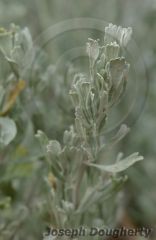
|
Big sage brush
Anthemideae/ artemisia tridentata < shrub that can be up to 6 meters tall < tridentate leaves, leaf wedge shaped, straight sides < leaves with dense gray hairs on both sides < flowers in a panicle with numerous heads, flowers often within the leaf canopy < Artemisia for Queen Artemisia of Asia; tridentata translates to tri=“three” + dentata=“teeth” |
|

|
(Rubber Rabbitbrush) W P N 246
Astereae/ Chrysothamnus nauseosus < heads in rounded, terminal cymes < a deciduous shrub, up to 2 m tall < several erect stems from base spreading in broom-like fashion < stems tomentous (felt-like); bark fibrous (white or greenish scruffy stems) < leaves are simple and linear with prominent midvein: leaves alternate, simple, sessile < flowers yellow forming crown-like racemes at the ends of each branch < member of the Astereae tribe of the Asteraceae family < Chrysothamnus means chryso=”yellow” + thamnus=”shrub-like”; nauseosus = “nauseating” |
|
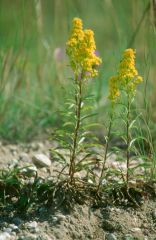
|
(Missouri Goldenrod) W P N 254
Astereae/ Solidago missouriensis < herbaceous forb with erect stems usually arising singly from a creeping rhizome < brownish or reddish stems < Flower base white hairs < leaves taper at both ends, entire or only slightly serrated; Caducous leaves reduced upward; < leaves have distinct veins parallel to margin; 3 or more main veins; “road-map” veination < inflorescence panicle-like with recurving branches (e.g. curved pyramidal inflorescence) Broader than is tall < member of the Astereae tribe of the Asteraceae family < Solidago = “united”; missouriensis = “from Missouri” |
|
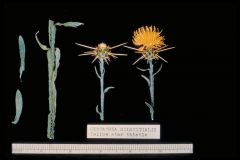
|

(Yellow Starthistle) C A I 945
Cynareae/ Centaurea solstitialis < winter annual, overwinters as rosette with deeply lobed leaves up to 8 inches long < in early spring plant develops stems with leaves up to 4 inches long, highly branched < blades forming fringe-like extensions (pinnatified) up to ½ to 1 inch long < yellow flower heads develop at the tips of branched stems from late spring until fall < flower head bracts develop stiff,sharp thorns ¾ inch long < Centaurea was named for Centaur a mythical creature with the body of a horse and the torso, head and arms of a man; solstitialis = “of mid-summer” |
|
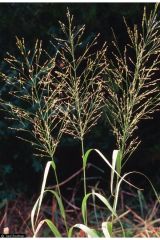
|
(Switchgrass) W1 P 2 N 3 1524
Paniceae/ Panicum virgatum < rhizomatous tallgrass with stout culms up to 3m in height. < seedhead is a broad and diffuse panicle with spikelets toward ends of panicle branches < each spikelet has one floret < first glume 2/3 to 3/4 as long as the spikelet. encase base of second glume. < lemma looks like a glume so spikelets appear to have 3 glumes < liguals tuft of hair at throat of sheath < Panicum refers to the panicle seedhead; virgatum means “with strait slender twigs” |
|
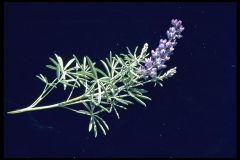
|
(Tailcup Lupine) C P N 354
Fabaceae/ Lupinus caudatus < forb with erect stems < leaves palmately compound with 7-9 lance-shaped leaflets < leaves long petiole with stiff to silky hairs < flowers are irregular in shape, occur in terminal racemes, and are blue to deep violet < Lupinus is an ancient Latin name for white lupine; caudatus = “tailed” |
|
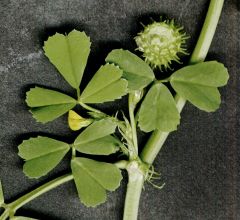
|
(Burclover) C A I 356
Fabaceae/ Medicago polymorpha < small forb with prostrate to ascending stems and an annual-type taproot < leaves pinnately trifoliate (3-leaved), resembles clover < leaflets notched at the apex < fruit a spirally-coiled bur with spines < Medicago is the Persian name for “grass”; polymorpha translates to poly = ”many” + morpha = ”forms” |
|
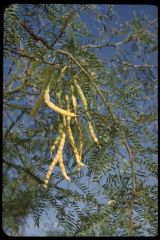
|
(Honey Mesquite) W P N 360
Fabaceae/ Prosopis glandulosa < shrub to small tree < flowers, perfect, regular, campanulate < ridged stems with long, straight, rigid spines < leaves are compound with 2 pinnae connected in a “Y” shape; each branch with 6-30 pairs of leaflets < leaflets are longer and wider than the leaflets found on the Acacias; main veins are yellow and merge at leaf edge < fruits are pods; long, straight or slightly curving, with obvious constrictions between seeds < Prosopis = a Greek name for the burdock, but unknown why it applies to this plant; glandulosa = “full of glands or glandular” |
|
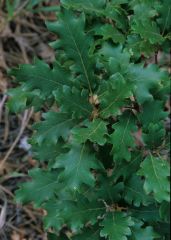
|
(Gambel Oak) C P N 364
Fagaceae/ Quercus gambelii < shrub or small tree usually growing in dense stands < bark is light gray to white (other Quercus barks are darker)< leaves alternate and simple; deeply 5-9 lobed and oval in outline < acorn cup encloses 1/4 to 1/3 of the nut < Quercus is an old Latin name for Oak; gambelii = named for Gambel (whoever he was) |
|
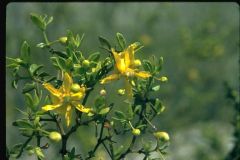
|
(Creosotebush) E P N 432
Zygophyllaceae/ Larrea tridentata < shrub with no well-defined trunk < stems and branches black with conspicuous dark nodes giving the stems and branches a "bumpy" appearance (like knots in a lariat rope) < stems resinous, emit creosote odor when moist or burned < leaves made of 2 leaflets fused at the base; each leaf looks like a set of horns < leaves are leathery, and are glossy dark green < leaves are opposite, nearly sessile < fruit a spherical capsule densely covered with long woolly hairs (white, red) and ending with a thread-like tip (stalk) < Larrea means after Bishop Juan Antonio Hernandez Perez de Larrea, a Spanish clergyman and scientist(1731-1803); tridentata translates to tri=”three”+dentate=”toothed” (not sure what is 3 toothed). |
|
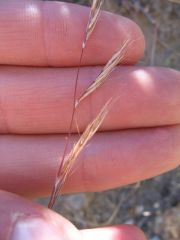
|
(Black Grama) W1 P 2 N3 844
Cynodoneae/ Bouteloua eriopoda < stoloniferous grass forming a weak sod < seedhead has 3-5 spicate, comb-like, branches per culm < spicate branches shorter and less dense than Bouteloua gracilis or B. hirsuta < awns as long or longer than spikelets < internodes pubescent, covered by glabrous sheaths giving it an alternate “hairy/not-hair” appearance. < Bouteloua named after the brothers Claudio and Esteban Boutelou, Spanish botanists and horticulturists; eriopoda means hairy (erio) foot (poda) |
|
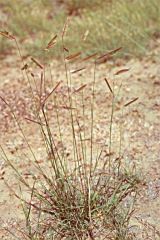
|
(Blue Grama) W P N 86
Cynodoneae/ Bouteloua gracilis < densely tufted plant with short, mostly basal, leaves < inflorescence has 1-3 (normally 2) spicate branches (combs) per culm < spikelets are densely crowded on comb-like branches < glumes not hairy as in B. hirsuta < rachis does not extend past the end of the comb (spicate branch) < compare to B. Hirsuta < Bouteloua named after the brothers Claudio and Esteban Boutelou, Spanish botanists and horticulturists; gracilis = slender or graceful |
|
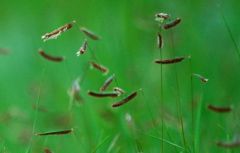
|
(Hairy Grama) W P N 88
Cynodoneae/ Bouteloua hirsuta < a short tufted grass with mostly basal leaves < leaves short and usually hairy < spikelets are arranged on 1-4 short branches on a simple panicle < spikelets are crowded on the branch and the rachis extends past the end of the comb < glumes with hairs originating from bulbous base < very similar to B. gracilis < Bouteloua named after the brothers Claudio and Esteban Boutelou, Spanish botanists and horticulturists; hirsuta = rough-haired or hairy |
|
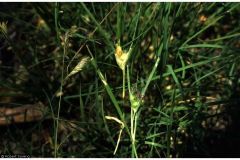
|
(Buffalograss) W P N 92
Cynodoneae/ Buchloe dactyloides < a shortgrass that is stoloniferous and forms a dense sod < male and female plants separate (dioecious) < male spikelets are arranged on spicate inflorescence branch (6-12 spikelets/branch) much like Bouteloua but spikelets are much longer < female spikelets 1-flowered, in bur-like clusters in basal portion of plant < Buchloe = "bous", meaning cow or ox and + "chloe", meaning grass; dacyloides = like a (oides) finger (dactyl) |
|

|
(Prairie Cordgrass) W P N 100
Cynodoneae/ Spartina pectinata < rhizomatous tall-grasses that are stout and husky < leaf blades with serrated margins, stout and don’t curl much at maturity < inflorescence with 6-40 spikelets per comblike branch < glume with awns and teeth on back < combs fairly continuous (not sparse) on inflorescence < Spartina is a old term for plant used to make rope; pectinata = “comb-like or pectinate” |
|
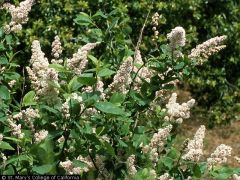
|
(Deerbrush) W P N 396
Rhamnaceae/ Ceanothus integerrimus < shrub widely and loosely branched with slender branches < branches often green to yellow and often drooping at the ends < leaves distinctly 3-veined, light green above, paler and pubescent beneath < leaves resemble C. velutinus but are not waxy "varnished"on the upper surface with smooth margins < flowers white to dark blue in terminal clusters < Ceanothus = “like a thistle”; integerrimus = “undivided, entire, or intact” |
|
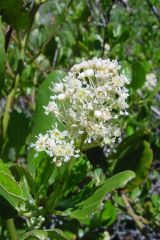
|
(Snowbrush) E P N 398
Rhamnaceae/ Ceanothus velutinus < mid-sized (to 2 m tall) shrub with branches originating a the base and forming a diffuse crown < leaves broadly ovate, margins closely serrated, upper leaf surface appears "varnished" or waxy, lower surface paler < leaves with 3 distinct main veins < flowers white in clusters < Ceanothus = “like a thistle”; velutinus = with a soft silky, velvet-like, covering |

